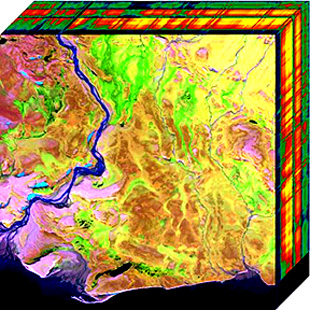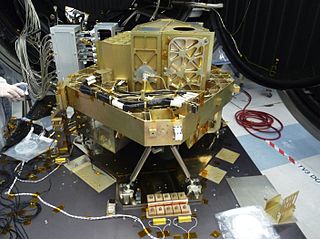
An optical spectrometer is an instrument used to measure properties of light over a specific portion of the electromagnetic spectrum, typically used in spectroscopic analysis to identify materials. The variable measured is most often the irradiance of the light but could also, for instance, be the polarization state. The independent variable is usually the wavelength of the light or a unit directly proportional to the photon energy, such as reciprocal centimeters or electron volts, which has a reciprocal relationship to wavelength.

The W. M. Keck Observatory is an astronomical observatory with two telescopes at an elevation of 4,145 meters (13,600 ft) near the summit of Mauna Kea in the U.S. state of Hawaii. Both telescopes have 10 m (33 ft) aperture primary mirrors, and when completed in 1993 and 1996 were the largest optical reflecting telescopes in the world. They are currently the 3rd and 4th largest.

The Gran Telescopio Canarias is a 10.4 m (410 in) reflecting telescope located at the Roque de los Muchachos Observatory on the island of La Palma, in the Canaries, Spain. It is the world's largest single-aperture optical telescope.

The Galileo National Telescope, is a 3.58-meter Italian telescope, located at the Roque de los Muchachos Observatory on the island of La Palma in the Canary Islands, Spain. The TNG is operated by the "Fundación Galileo Galilei, Fundación Canaria", a non-profit institution, on behalf of the Italian National Institute of Astrophysics (INAF). The telescope saw first light in 1998 and is named after the Italian Renaissance astronomer Galileo Galilei.

The William Herschel Telescope (WHT) is a 4.20-metre (165 in) optical/near-infrared reflecting telescope located at the Roque de los Muchachos Observatory on the island of La Palma in the Canary Islands, Spain. The telescope, which is named after William Herschel, the discoverer of the planet Uranus, is part of the Isaac Newton Group of Telescopes. It is funded by research councils from the United Kingdom, the Netherlands and Spain.

The Wide Field and Planetary Camera 2 (WFPC2) is a camera formerly installed on the Hubble Space Telescope. The camera was built by the Jet Propulsion Laboratory and is roughly the size of a baby grand piano. It was installed by servicing mission 1 (STS-61) in 1993, replacing the telescope's original Wide Field and Planetary Camera (WF/PC). WFPC2 was used to image the Hubble Deep Field in 1995, the Engraved Hourglass Nebula and Egg Nebula in 1996, and the Hubble Deep Field South in 1998. During STS-125, WFPC2 was removed and replaced with the Wide Field Camera 3 as part of the mission's first spacewalk on May 14, 2009. After returning to Earth, the camera was displayed briefly at the National Air and Space Museum and the Jet Propulsion Laboratory before returning to its final home at the Smithsonian's National Air and Space Museum.

The NASA Infrared Telescope Facility is a 3-meter (9.8 ft) telescope optimized for use in infrared astronomy and located at the Mauna Kea Observatory in Hawaii. It was first built to support the Voyager missions and is now the US national facility for infrared astronomy, providing continued support to planetary, solar neighborhood, and deep space applications. The IRTF is operated by the University of Hawaii under a cooperative agreement with NASA. According to the IRTF's time allocation rules, at least 50% of the observing time is devoted to planetary science.

The Mercator Telescope is a 1.2 m telescope at the Observatorio del Roque de Los Muchachos on La Palma. It is operated by the Katholieke Universiteit Leuven, Belgium, in collaboration with the Observatory of the University of Geneva and named after Gerard Mercator, famous cartographer.

A multi-object spectrometer is a type of optical spectrometer capable of simultaneously acquiring the spectra of multiple separate objects in its field of view. It is used in astronomical spectroscopy and is related to long-slit spectroscopy. This technique became available in the 1980s.

Hyperspectral imaging collects and processes information from across the electromagnetic spectrum. The goal of hyperspectral imaging is to obtain the spectrum for each pixel in the image of a scene, with the purpose of finding objects, identifying materials, or detecting processes. There are three general types of spectral imagers. There are push broom scanners and the related whisk broom scanners, which read images over time, band sequential scanners, which acquire images of an area at different wavelengths, and snapshot hyperspectral imagers, which uses a staring array to generate an image in an instant.

The Cosmic Origins Spectrograph (COS) is a science instrument that was installed on the Hubble Space Telescope during Servicing Mission 4 (STS-125) in May 2009. It is designed for ultraviolet (90–320 nm) spectroscopy of faint point sources with a resolving power of ≈1,550–24,000. Science goals include the study of the origins of large scale structure in the universe, the formation and evolution of galaxies, and the origin of stellar and planetary systems and the cold interstellar medium. COS was developed and built by the Center for Astrophysics and Space Astronomy (CASA-ARL) at the University of Colorado at Boulder and the Ball Aerospace and Technologies Corporation in Boulder, Colorado.

The Wide Field Camera 3 (WFC3) is the Hubble Space Telescope's last and most technologically advanced instrument to take images in the visible spectrum. It was installed as a replacement for the Wide Field and Planetary Camera 2 during the first spacewalk of Space Shuttle mission STS-125 on May 14, 2009.

The Spektr-UV, also known as World Space Observatory-Ultraviolet (WSO-UV), is a proposed ultraviolet space telescope intended for work in the 115 nm to 315 nm wavelength range. It is an international project led by Russia (Roscosmos), with participation from Spain and Japan. The launch had initially been planned for 2007, but has since been continually delayed; as of February 2023, the launch is planned for the end of 2028 atop an Angara A5M rocket from Vostochny Cosmodrome.

Integral field spectrographs (IFS) combine spectrographic and imaging capabilities in the optical or infrared wavelength domains (0.32 μm – 24 μm) to get from a single exposure spatially resolved spectra in a bi-dimensional region. The name originates from the fact that the mesurements result from integrating the light on multiple sub-regions of the field. Developed at first for the study of astronomical objects, this technique is now also used in many other fields, such bio-medical science and Earth remote sensing. Integral field spectrography is part of the broader category of snapshot hyperspectral imaging techniques, itself a part of hyperspectral imaging.

An astronomical filter is a telescope accessory consisting of an optical filter used by amateur astronomers to simply improve the details and contrast of celestial objects, either for viewing or for photography. Research astronomers, on the other hand, use various band-pass filters for photometry on telescopes, in order to obtain measurements which reveal objects' astrophysical properties, such as stellar classification and placement of a celestial body on its Wien curve.

The NIRSpec is one of the four scientific instruments flown on the James Webb Space Telescope (JWST). The JWST is the follow-on mission to the Hubble Space Telescope (HST) and is developed to receive more information about the origins of the universe by observing infrared light from the first stars and galaxies. In comparison to HST, its instruments will allow looking further back in time and will study the so-called Dark Ages during which the universe was opaque, about 150 to 800 million years after the Big Bang.

Fine Guidance Sensor and Near Infrared Imager and Slitless Spectrograph (FGS-NIRISS) is an instrument on the James Webb Space Telescope (JWST) that combines a Fine Guidance Sensor and a science instrument, a near-infrared imager and a spectrograph. The FGS/NIRISS was designed by the Canadian Space Agency (CSA) and built by Honeywell as part of an international project to build a large infrared space telescope with the National Aeronautics and Space Administration (NASA) and the European Space Agency (ESA). FGS-NIRISS observes light from the wavelengths of 0.8 to 5.0 microns. The instrument has four different observing modes.

NIRCam is an instrument aboard the James Webb Space Telescope. It has two major tasks, as an imager from 0.6 to 5 micron wavelength, and as a wavefront sensor to keep the 18-section mirrors functioning as one. In other words, it is a camera and is also used to provide information to align the 18 segments of the primary mirror. It is an infrared camera with ten mercury-cadmium-telluride (HgCdTe) detector arrays, and each array has an array of 2048×2048 pixels. The camera has a field of view of 2.2×2.2 arc minutes with an angular resolution of 0.07 arcsec at 2 microns. NIRCam is also equipped with coronagraphs, which helps to collect data on exoplanets near stars. It helps with imaging anything next to a much brighter object, because the coronagraph blocks that light.

The Goode Solar Telescope (GST) is a scientific facility for studies of the Sun named after Philip R. Goode. It was the solar telescope with the world's largest aperture in operation for more than a decade. Located in Big Bear Lake; California, the Goode Solar Telescope is the main telescope of the Big Bear Solar Observatory operated by the New Jersey Institute of Technology (NJIT). Initially named New Solar Telescope (NST), first engineering light was obtained in December 2008, and scientific observations of the Sun began in January 2009. On July 17, 2017, the NST was renamed in honor of Goode, a former, and founding director of NJIT's Center for Solar-Terrestrial Research and the principal investigator of the facility. Goode conceived, raised the funds, and assembled the team that built and commissioned the telescope, and it was the highest resolution solar telescope in the world (until the end of 2019) and the first facility class solar telescope built in the U.S. in a generation.

Donatiello I, also known as Mirach's Goblin, is a dwarf spheroidal galaxy in the constellation Andromeda, located between 8.1 and 11.4 million light-years from Earth. It is a possible satellite galaxy of the dwarf lenticular galaxy NGC 404, "Mirach's Ghost", which is situated 60 arcminutes away. It is otherwise one of the most isolated dwarf spheroidal galaxies known, being separated from NGC 404 by around 211,000 light-years. The galaxy is named after its discoverer, amateur astrophotographer Giuseppe Donatiello, who sighted the galaxy in a 2016 review of his archival long exposures from 2010 and 2013. Follow-up observations with the Roque de los Muchachos Observatory led to a scientific paper on its discovery being published in December 2018.